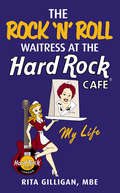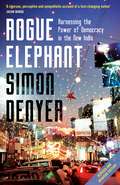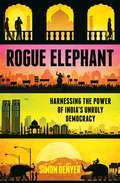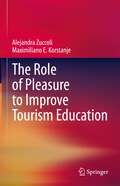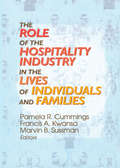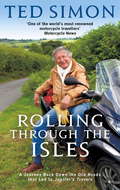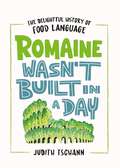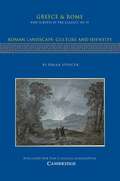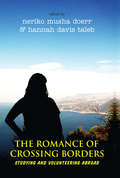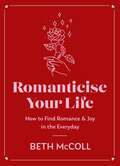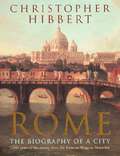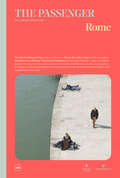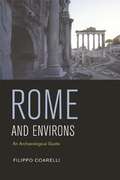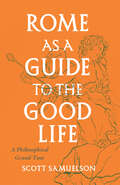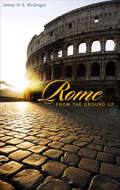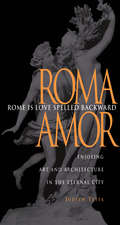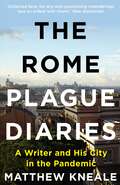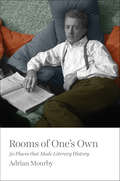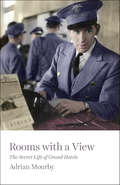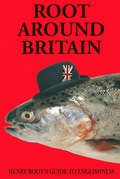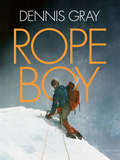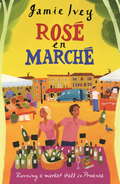- Table View
- List View
The Rock 'N’ Roll Waitress at the Hard Rock Cafe: My Life
by Rita GilliganMeet Rita Gilligan, Hard Rock Cafe’s original ‘Rock ‘n’ Roll’ waitress and international cultural ambassador and MBE. It was 1971 when Hard Rock first opened its doors in London, and Rita was there with her spunky, chatty, and absolutely lovable personality. Over the forty-five years she served at Hard Rock, Rita has collected quite some stories to tell, including her relationship with rock ‘n’ roll celebrities, Hard Rock’s history, and her own personal life struggles. In this book Rita tells her story from being a shy Catholic schoolgirl in Galway to becoming the best known waitress and later ambassador of one of history's most iconic American style restaurants. She also narrates how she met Paul McCartney, Eric Clapton, The Rolling Stones, Bruce Springsteen and many other famous celebrities during her time at the Hard Rock. Written with candid humour and disarming honesty, Rita serves up a brilliantly crafted story about how the Hard Rock, like herself, defied all the odds to become a global phenomenon.
Rogue Elephant: Harnessing the Power of India’s Unruly Democracy
by Simon DenyerAt the beginning of the twenty-first century, India stood on the brink of an exciting new era. Yet only a decade later, a series of corruption scandals and acts of violence against women had tarnished the nation's image and slowed her economic growth. When Narendra Modi became India's fifteenth prime minister in May 2014, he promised to revitalise a nation which seemed to have lost its way. With a record turnout, the elections were a powerful testament to Indians' aspirations for a brighter future. Rogue Elephant uncovers the gripping struggle between powerful vested interest groups and those trying to foster change. Simon Denyer exposes the failures that undermined India's self-confidence and paved the way for Modi's triumphant victory, but also examines the heroic efforts of those who are fighting for a better future in the world's largest democracy.
Rogue Elephant: Harnessing the Power of India’s Unruly Democracy
by Simon DenyerFive years ago, India was an emerging world power being courted by the world's most powerful political and business leaders, an upbeat story of unparalleled economic growth. Since then, it has failed to account for the human capital at the heart of its effort to modernize: more than one billion people clamoring for what has become known as the "Indian Dream"--an education, a career, and an opportunity to pull one's family out of poverty and into prosperity. Today, India is suffering an immense crisis of confidence--crippling political corruption, politicians mired in the status quo, economic inequality, brutal violence against women, and rampant social injustice. Simon Denyer, former Indian bureau chief for the Washington Post, perceptively captures India at this crucial tilting point in its history--from the Nehru-Gandhi family dynasty that has ruled the country for most of its post-independence years, to flawed heroes such as news anchor Arnab Goswami and anticorruption crusader Arvind Kejwiral, to, most compelling, ordinary people fighting daily against corruption and the system. They, Denyer convincingly shows, are harnessing the force of the world's largest democracy to positive effect, demanding transparency and accountability as never before. The battle between the deep-rooted system of graft and patronage and the forces demanding change will have huge global significance, and Denyer's insight makes Rogue Elephant a vital contribution to the international conversation about India's present and future.
The Role of Pleasure to Improve Tourism Education
by Alejandra Zuccoli Maximiliano E. KorstanjeThis book discusses how pleasure, as an emotional motivation, can play a leading role in improving the learning of new cognitive skills and abilities. Set in a research center orientated to innovate educative techniques for optimizing the learning process, this case study is focusing on the power of pleasure (joy) as a strategy to better the standard education systems in Argentina and beyond.This editorial project is based on an efficient experiment known as “PANCOE” where pre-graduate students of tourism bachelor at the University of Palermo, Argentina, were subject to different pleasurable experiences mainly marked by eating, tasting dishes and non-alcohol drinks while cooking and kneading bread pieces. PANCOE aims to integrate students' senses with their emotions, academic performance, and digital platforms. PANCOE devotes efforts to transforming negative feelings like fear into positive ones like joy. As an outcome, students who had taken part in PANCOE not only obtained higher degrees but also completed their studies with a bachelor's degree. Therefore, PANCOE situates as a promising and exciting tourism education method to better the academic performance of low-grade students in tourism and to bring creativity to the tourism classroom for all students.
The Role of the Hospitality Industry in the Lives of Individuals and Families
by Pamela R Cummings Francis A Kwansa Marvin B SussmanThe Role of the Hospitality Industry in the Lives of Individuals and Families explores the evolution of the hospitality industry and the relationships between hospitality providers, their families, and the guests they serve. Focusing on the human aspect of the business, this text will give hospitality providers a better understanding of the human relations issues that they or their employees may face and show them how your services affect guests. Offering research and insight into customs and traditions that have influenced modern services, The Role of the Hospitality Industry in the Lives of Individuals and Families will teach you how to better meet the needs of guests at the national or international level while learning how the industry affects employees and their lives outside of work.The Role of the Hospitality Industry in the Lives of Individuals and Families discusses many different themes that relate to the improvement of the profession for both guests and employees, such as the spiritual, philosophical, and historical provisions of hospitality; the human resource and work issues of employees in the industry; consumer and family demands; and marketing strategies for hospitality organizations. In addition, this text discusses many issues that affect guests and that affect you as an employer or employee, such as: responding to the needs of travelers for a “home away from home” dealing with the social and health issues of guests recognizing the changing food habits of Americans and their impact on the hospitality industry examining the frequently negative attitude of Americans toward service hospitality employees balancing a career in the hospitality industry and family life researching the frequency of fast food patronage by older adults and the importance of hotel/motel services to older adults to determine if areas of service need improvement protecting employees from overly demanding guests balancing compassion, generosity, and idealism with the corporate profit maximization mandateThe Role of the Hospitality Industry in the Lives of Individuals and Families also examines the cultural relationships fostered by the hospitality industry as a benefit and proof of quality services. Complete with ideas for further research, this text will help you and your employees evaluate the personal effects of the hospitality industry and help provide better services to guests.
The Role of the Hospitality Industry in the Lives of Individuals and Families
by Pamela R Cummings Francis A Kwansa Marvin B SussmanThe Role of the Hospitality Industry in the Lives of Individuals and Families explores the evolution of the hospitality industry and the relationships between hospitality providers, their families, and the guests they serve. Focusing on the human aspect of the business, this text will give hospitality providers a better understanding of the human relations issues that they or their employees may face and show them how your services affect guests. Offering research and insight into customs and traditions that have influenced modern services, The Role of the Hospitality Industry in the Lives of Individuals and Families will teach you how to better meet the needs of guests at the national or international level while learning how the industry affects employees and their lives outside of work.The Role of the Hospitality Industry in the Lives of Individuals and Families discusses many different themes that relate to the improvement of the profession for both guests and employees, such as the spiritual, philosophical, and historical provisions of hospitality; the human resource and work issues of employees in the industry; consumer and family demands; and marketing strategies for hospitality organizations. In addition, this text discusses many issues that affect guests and that affect you as an employer or employee, such as: responding to the needs of travelers for a “home away from home” dealing with the social and health issues of guests recognizing the changing food habits of Americans and their impact on the hospitality industry examining the frequently negative attitude of Americans toward service hospitality employees balancing a career in the hospitality industry and family life researching the frequency of fast food patronage by older adults and the importance of hotel/motel services to older adults to determine if areas of service need improvement protecting employees from overly demanding guests balancing compassion, generosity, and idealism with the corporate profit maximization mandateThe Role of the Hospitality Industry in the Lives of Individuals and Families also examines the cultural relationships fostered by the hospitality industry as a benefit and proof of quality services. Complete with ideas for further research, this text will help you and your employees evaluate the personal effects of the hospitality industry and help provide better services to guests.
Rolling Through The Isles: A Journey Back Down the Roads that led to Jupiter
by Ted SimonFrom the bestselling author of Jupiter's Travels and Dreaming of Jupiter comes an entertaining and inspiring new journey round Britain.Having crisscrossed the globe twice, Ted returns to the British Isles to rediscover the country of his youth. The result is a revealing portrait of modern Britain and a witty and affectionate journey back to the past, when Ted would hitchhike across the country visiting friends (and girlfriends).He returns to the site of his old school with its astonishing war time history and visits familiar haunts where he did his National Service and got his first job in newspapers. He also visits less-familiar places. Some inspire him (Winchester Cathedral). Others defeat him (a tax office in Nottingham). As he rolls through the Isles, he discovers that a great deal has changed: busier roads, bureaucracy and, worst of all, the dreaded 'Sat Nav'. But there is also much to celebrate and enjoy along the way.Packed with fascinating stories, extraordinary encounters and glorious depictions of the British countryside, Rolling through the Isles takes the reader on an unforgettable trip with a celebrated adventurer and writer.
Romaine Wasn't Built in a Day: The Delightful History of Food Language
by Judith TschannPerfect for readers of Susie Dent and Mark Forsyth, and fans of QI. All food has a story, reaching as far back into history as language itself. As languages followed and reflected the tides of civilizations, food language came to represent some of the highs and lows of how humans communicate: from the highbrow 'Chateauneuf du Pape: (the Pope's new castle)' to the 'nun's farts' of Jamaica (also known as 'beignets').Chock full of food puns, linguistic did-you-knows and delectable trivia, Romaine Wasn't Built in A Day is your go-to gift for your trivia nerds, your history buffs, your crossword fiends, and your Scrabble diehards. This is the surprising and hilarious history of food, told through the lens of the fascinating evolution of language.
Roman Landscape: Culture And Identity (New Surveys In The Classics Ser. #39)
by Diana SpencerThis book tackles how and why 'landscape' (farms, gardens, countryside) set the scene in the first centuries BCE and CE for Romans keen to talk up and about (but also to scrutinize and understand) what it meant to be a citizen. It investigates what 'landscape' means now and reflects upon how contemporary approaches to 'landscape' can enrich our understanding of ancient experience of the interface between natural and artificial space. It encourages examination of 'landscape' from a range of angles, suggesting alternative ways of thinking about what landscape represents. These methodological approaches (presented initially via a set of key terms and definitions and then deployed thematically across four chapters), combined with a detailed interdisciplinary bibliography and a series of case studies of literary texts and material sites, enable readers to use this survey as a starting point for developing their own in-depth study.
The Romance of Crossing Borders: Studying and Volunteering Abroad
by Neriko Musha Doerr and Hannah Davis TaïebWhat draws people to study abroad or volunteer in far-off communities? Often the answer is romance – the romance of landscapes, people, languages, the very sense of border-crossing – and longing for liberation, attraction to the unknown, yearning to make a difference. This volume explores the complicated and often fraught desires to study and volunteer abroad. In doing so, the book sheds light on how affect is managed by educators and mobilized by students and volunteers themselves, and how these structures of feeling relate to broader social and economic forces.
The Romance of the Colorado River
by Frederick S. DellenbaughIn 1871, seventeen-year-old Fred Dellenbaugh walked into a hotel room in Chicago, and with a “You’ll do, Fred,” began a lifetime of danger-fraught exploration. Under the lead of John Wesley Powell, a Civil War hero with only one arm, Fred journeyed into the Grand Canyon and its subsidiary canyons and rivers, with the intention of exploring, mapping, and recording description of the uncharted territory. The men found themselves battling the great force of the Colorado River, with its fatal, quick rapids and mighty waterfalls. Their small, frail boats were no match for the river, and as they began to capsize and as supplies were lost overboard, the expedition quickly became about survival. It was only through the steady command of Major Powell that the team prevailed. They went on to accomplish their mission, which has become historically significant today. <P><P> The Romance of the Colorado River is Dellenbaugh’s personal story, written thirty years after the great adventure. The volume includes twenty of the author’s original illustrations, as well as nearly 150 contemporary photographs, which provide an accurate image of what the explorers encountered during their expedition. Dellenbaugh also recounts previous attempts to explore the valley, by both Europeans and fellow Americans, adding a historical element to the story. Part adventure narrative and part geography survey of the Colorado River, this book offers a unique firsthand account of a fascinating scientific expedition.
Romanticise Your Life: How to find joy in the everyday
by Beth McColl'Romanticise Your Life came at a time when I really needed it. Beth's writing has helped me to discover the joy all around me' - ANNIE LORD, author of NOTES ON HEARTBREAKExploring all areas of life from solo travelling to the joy of friendships, tapping into your Main Character Energy, and taking control of your dating life, in this beautifully illustrated must-have guide Beth McColl shows you how romance is about appreciating the small things, because they can be just as magnificent as meeting the love of your life.Everyday romance might be:· Cooking yourself an elaborate meal· Going on a solo trip to the seaside· Writing a letter to an old friend · Texting someone out of the blue just to let them know you're missing them· Smiling at a handsome stranger on the train just before your stopEmpowered by Beth's uplifting anecdotes and inspiring tips, you will discover that whether it's a grand gesture, or just simply appreciating how the sun rises anew each day, life is about making the most of the moments we're given...Because joy and romance start with you.
Rome: The Biography of a City (Penguin Nonfiction Ser.)
by Christopher HibbertThis beautifully written, informative study is a portrait, a history and a superb guide book, capturing fully the seductive beauty and the many layered past of the Eternal City. It covers 3,000 years of history from the city’s quasi-mythical origins, through the Etruscan kings, the opulent glory of classical Rome, the decadence and decay of the Middle Ages and the beauty and corruption of the Renaissance, to its time at the heart of Mussolini’s fascist Italy. Exploring the city’s streets and buildings, peopled with popes, gladiators, emperors, noblemen and peasants, this volume details the turbulent and dramatic history of Rome in all its depravity and grandeur.
Rome: The Passenger (The Passenger)
by Various“Fresh and diverting, informative and topical without being slight or ephemeral [...] This supremely well-edited combination of current affairs, journalism, commentary, and fun facts is perfect for our pause-button moment.”–Australian Financial Review, Best Books of the Year IN THIS VOLUME: Rome doesn’t judge you by Nicola Lagioia・The soul of the city by Matteo Nucci・39 memos for a book about Rome by Francesco Piccolo Plus: a guide to the sounds of Rome; the feigned unrest and real malaise of the suburbs; the influence of the Vatican; the excessive power of real estate speculators and the rule of gangs; disillusioned trappers; football fans of every age, and much more... If you believe what’s currently being said about Rome, the city is on the verge of collapse. Each year, it slips further down the ranking of the world’s most liveable cities. To the problems faced by all large capitals, Rome has added a list of calamities of its own: a string of failing administrations, widespread corruption, the resurgence of fascist movements, rampant crime. A seemingly hopeless situation, perfectly symbolized by the fact that Rome currently leads the world in the number of self-combusting public buses. If we look closer this narrative is contradicted by just as many signs that point in the opposite direction. Above all, the lack of the mass emigration one would except in these circumstances: the vast majority of Romans don’t think for a second of “betraying” their hometown, and the many newcomers who have populated it in recent decades are often indistinguishable from the natives in the profound love that binds them to the city. Rome is a place of contradictions: an “incredibly deceptive city”, always different from what it appears to be. Thought to be large, it is actually immense, the largest metropolis in Europe. Contrary to the most common stereotype, Rome is a profoundly modern city. Founded almost three millennia ago, 92 per cent of its buildings were built after 1945. The bottom line is that, in order to understand Rome and fix its problems, we should consider it a normal city, “not unlike Chicago or Manchester.” Only, incomparably more beautiful.
Rome and Environs: An Archaeological Guide (PDF)
by Filippo CoarelliThis superb guide at last brings the work of Filippo Coarelli, one of the most widely published and best known scholars of Roman archeology and art, to a wide, English-language audience. Conveniently organized by walking tours and illustrated throughout with clear maps, drawings, and plans, "Rome and Environs: An Archaeological Guide" covers all of the city's ancient sites, and, unlike most other guides, now includes the major monuments in a large area outside Rome proper but within easy reach, such as Ostia Antica, Palestrina, Tivoli, and the many areas of interest along the ancient Roman roads.An essential resource for tourists interested in a deeper understanding of Rome's classical remains, it is also the ideal book for students and scholars approaching the ancient history of one of the world's most fascinating cities. Covers all the major sites including the Capitoline, the Roman Forum and the Imperial Fora, the Palatine Hill, the Valley of the Colosseum, the Esquiline, the Caelian, the Quirinal, and the Campus Martius. Two separate chapters discuss important clusters of sites-one on the area surrounding Circus Maximus and the other in the vicinity of the Trastevere, including the Aventine and the Vatican. Additional chapters cover the city walls and the aqueducts. Features 189 maps, drawings, and diagrams; an appendix on building materials and techniques; and an extensive bibliography.
Rome as a Guide to the Good Life: A Philosophical Grand Tour
by Scott SamuelsonA unique, portable guidebook that sketches Rome’s great philosophical tradition while also providing an engaging travel companion to the city. This is a guidebook to Rome for those interested in both la dolce vita and what the ancient Romans called the vita beata—the good life. Philosopher Scott Samuelson offers a thinker’s tour of the Eternal City, rooting ideas from this philosophical tradition within the geography of the city itself. As he introduces the city’s great works of art and its most famous sites—the Colosseum, the Forum, the Campo de’ Fiori—Samuelson also gets to the heart of the knotty ethical and emotional questions they pose. Practicing philosophy in place, Rome as a Guide to the Good Life tackles the profound questions that most tours of Rome only bracket. What does all this history tell us about who we are? In addition to being a thoughtful philosophical companion, Samuelson is also a memorable tour guide, taking us on plenty of detours and pausing to linger over an afternoon Negroni, sample four classic Roman pastas, or explore the city’s best hidden gems. With Samuelson’s help, we understand why Rome has inspired philosophers such as Lucretius and Seneca, poets and artists such as Horace and Caravaggio, filmmakers like Fellini, and adventurers like Rosa Bathurst. This eclectic guidebook to Roman philosophy is for intrepid wanderers and armchair travelers alike—anyone who wants not just a change of scenery, but a change of soul.
Rome as a Guide to the Good Life: A Philosophical Grand Tour
by Scott SamuelsonA unique, portable guidebook that sketches Rome’s great philosophical tradition while also providing an engaging travel companion to the city. This is a guidebook to Rome for those interested in both la dolce vita and what the ancient Romans called the vita beata—the good life. Philosopher Scott Samuelson offers a thinker’s tour of the Eternal City, rooting ideas from this philosophical tradition within the geography of the city itself. As he introduces the city’s great works of art and its most famous sites—the Colosseum, the Forum, the Campo de’ Fiori—Samuelson also gets to the heart of the knotty ethical and emotional questions they pose. Practicing philosophy in place, Rome as a Guide to the Good Life tackles the profound questions that most tours of Rome only bracket. What does all this history tell us about who we are? In addition to being a thoughtful philosophical companion, Samuelson is also a memorable tour guide, taking us on plenty of detours and pausing to linger over an afternoon Negroni, sample four classic Roman pastas, or explore the city’s best hidden gems. With Samuelson’s help, we understand why Rome has inspired philosophers such as Lucretius and Seneca, poets and artists such as Horace and Caravaggio, filmmakers like Fellini, and adventurers like Rosa Bathurst. This eclectic guidebook to Roman philosophy is for intrepid wanderers and armchair travelers alike—anyone who wants not just a change of scenery, but a change of soul.
Rome from the Ground Up (From The Ground Up (hup) Ser. #4)
by James H. McGregorRome is not one city but many, each with its own history unfolding from a different center: now the trading port on the Tiber; now the Forum of antiquity; the Palatine of imperial power; the Lateran Church of Christian ascendancy; the Vatican; the Quirinal palace. Beginning with the very shaping of the ground on which Rome first rose, this book conjures all these cities, past and present, conducting the reader through time and space to the complex and shifting realities—architectural, historical, political, and social—that constitute Rome. A multifaceted historical portrait, this richly illustrated work is as gritty as it is gorgeous, immersing readers in the practical world of each period. James H. S. McGregor’s explorations afford the pleasures of a novel thick with characters and plot twists: amid the life struggles, hopes, and failures of countless generations, we see how things truly worked, then and now; we learn about the materials of which Rome was built; of the Tiber and its bridges; of roads, aqueducts, and sewers; and, always, of power, especially the power to shape the city and imprint it with a particular personality—like that of Nero or Trajan or Pope Sixtus V—or a particular institution. McGregor traces the successive urban forms that rulers have imposed, from emperors and popes to national governments including Mussolini’s. And, in archaeologists’ and museums’ presentation of Rome’s past, he shows that the documenting of history itself is fraught with power and politics. In McGregor’s own beautifully written account, the power and politics emerge clearly, manifest in the distinctive styles and structures, practical concerns and aesthetic interests that constitute the myriad Romes of our day and days past.
Rome Is Love Spelled Backward: Enjoying Art and Architecture in the Eternal City
by Judith TestaA celebration of the art, architecture, and timeless human passion of the Eternal City, Rome Is Love Spelled Backward explores Rome's best-known treasures, often revealing secrets overlooked in conventional guidebooks. With the ancient play on "Roma" and "Amor"—ROMAMOR—Testa invites readers to experience the world's long love affair with one of its most beautiful cities.
The Rome Plague Diaries: Lockdown Life in the Eternal City
by Matthew KnealeOn the first morning of Rome's Covid-19 lockdown Matthew Kneale felt an urge to connect with friends and acquaintances and began writing an email, describing where he was, what was happening and what it felt like, and sent it to everyone he could think of. He was soon composing daily reports as he tried to comprehend a period of time, when everyone's lives suddenly changed and Italy struggled against an epidemic, that was so strange, so troubling and so fascinating that he found it impossible to think about anything else. Having lived in Rome for eighteen years, Matthew has grown to know the capital and its citizens well and this collection of brilliant diary pieces connects what he has learned about the city with this extraordinary, anxious moment, revealing the Romans through the intense prism of the coronavirus crisis.
Rooms of One's Own: 50 Places That Made Literary History
by Adrian MourbyWriters’ relationships with their surroundings are seldom straightforward. While some, like Jane Austen and Thomas Mann, wrote novels set where they were staying (Lyme Regis and Venice respectively), Victor Hugo penned Les Misérables in an attic in Guernsey and Noël Coward wrote that most English of plays, Blithe Spirit, in the Welsh holiday village of Portmeirion. Award-winning BBC drama producer Adrian Mourby follows his literary heroes around the world, exploring 50 places where great works of literature first saw the light of day. At each destination – from the Brontës’ Yorkshire Moors to the New York of Truman Capote, Christopher Isherwood’s Berlin to the now-legendary Edinburgh café where J.K. Rowling plotted Harry Potter’s first adventures – Mourby explains what the writer was doing there and describes what the visitor can find today of that great moment in literature. Rooms of One’s Own takes you on a literary journey from the British Isles to Paris, Berlin, New Orleans, New York and Bangkok and unearths the real-life places behind our best-loved works of literature.
Rooms with a View: The Secret Life of Grand Hotels
by Adrian MourbySalvador Dalí once asked room service at Le Meurice in Paris to send him up a flock of sheep. When they were brought to his room he pulled out a gun and fired blanks at them. George Bernard Shaw tried to learn the tango at Reid’s Palace in Madeira, and the details of India’s independence were worked out in the ballroom of the Imperial Hotel, Delhi. The world’s grandest hotels have provided glamorous backgrounds for some of the most momentous – and most bizarre – events in history. Adrian Mourby is a distinguished hotel historian and travel journalist – and a lover of great hotels. Here he tells the stories of 50 of the world’s most magnificent, among them the Adlon in Berlin, the Hotel de Russie in Rome, the Continental in Saigon, Raffles in Singapore, the Dorchester in London, Pera Palace in Istanbul and New York’s Plaza, as well as some lesser known grand hotels like the Bristol in Warsaw, the Londra Palace in Venice and the Midland in Morecambe Bay. All human life is to be found in a great hotel, only in a more entertaining form.
Root Around Britain
by Will DonaldsonConveniently arranged in alphabetical order, from Abstractions (you'll find them on the Continent, of course') to Weather, Root Around Britain tells the story of a quest. A quest for the essence of Englishness; a quest for a new television series which Mr Root can sell to the fat man in Birmingham; a quest for a peerage and the right way to pay for it ('old money' or 'new money'?); and, finally, a quest for the means to humiliate a nosy neighbour. What could be more English than that?
Rope Boy: A life of climbing from Yorkshire to Yosemite
by Dennis GrayRope Boy is the story of Dennis Gray, a young lad from Leeds who gets his first taste of rock at age eleven, and goes on to become a prominent figure in the UK climbing scene for decades to come.Gray’s climbing career began with the ‘Bradford Lads’, climbing in Yorkshire, Scotland and Wales, exploring classic crags such as Clogwyn Du’r Arddu, tentatively venturing into an exciting new game, and inspired by the pioneering Arthur Dolphin. Just as the scene was rapidly developing in the 1950s, so was Gray’s desire to climb, and he was soon climbing with the Rock and Ice legends Joe Brown, Don Whillans and Nat Allen, among others, making first ascents such as North Crag Eliminate on Castle Rock in the Lake District and Grond on Dinas Cromlech in Wales.Larger objectives beckoned, and Gray embarked upon multiple expeditions to the Alps as well as to the Himalaya, the Andes, and America, making numerous first ascents along the way including the north ridge of Alpamayo in Peru’s Cordillera Blanca, and Mukar Beh in the Kulu valley of India.Rope Boy relays times of frustration, adventure and success, and the hilarious and dauntless friends with whom Gray shared his experiences. Dennis Gray’s transformation from rope boy to expedition leader is an inspiring and encouraging tale of one boy’s journey into adulthood via a world of rock, snow and ice.
Rose En Marche: Running A Market Stall In Provence
by Jamie IveyRosé en Marché, the third title in the 'rosé' series by Jamie Ivey, involves Tanya and Jamie selling rosé in French markets. They rent a flat in Saint Remy de Provence and work in the town's market as well as three or four other local markets. There is, of course, the odd flying visit from their old friend Peter. The Iveys decide to set up their own market stall in the exquisite Provencal town of Saint Remy. But they quickly uncover a battleground. Artisan traders fight competitors selling imports of lavender from Bulgaria, rip-off tableware from China and wholesale vegetables artificially smattered with dirt. Rumours of bribery and corruption are ever present as traders scramble for the best pitches. But can the Iveys make a go of their own stall . . .?
